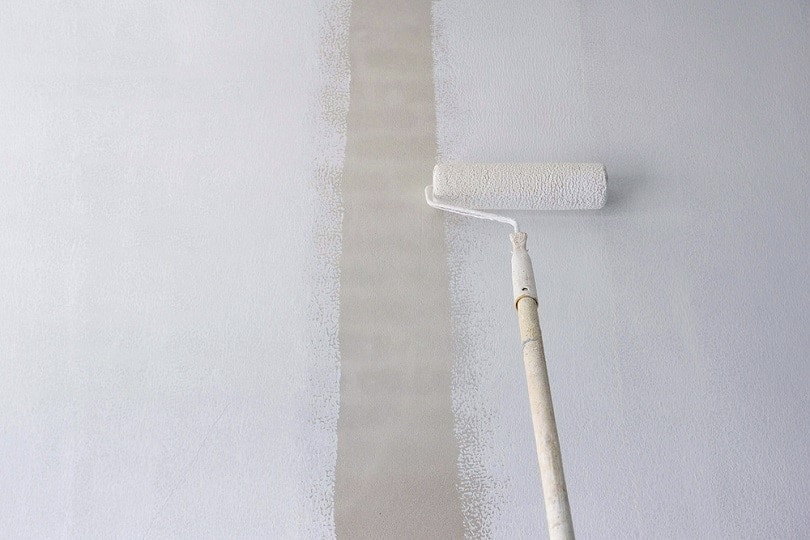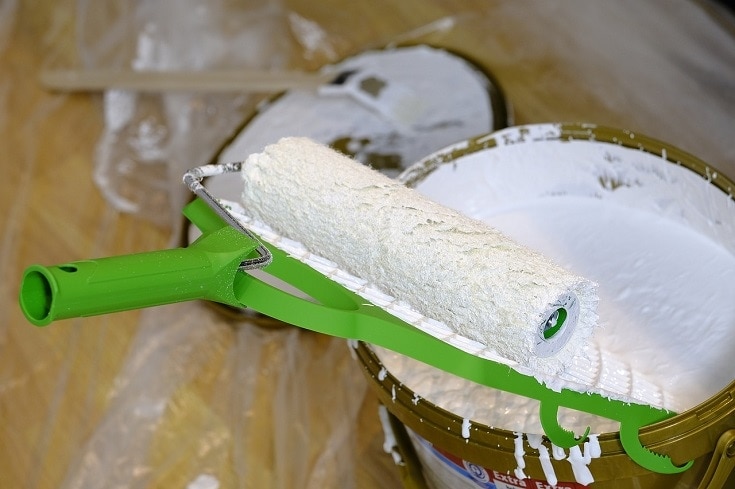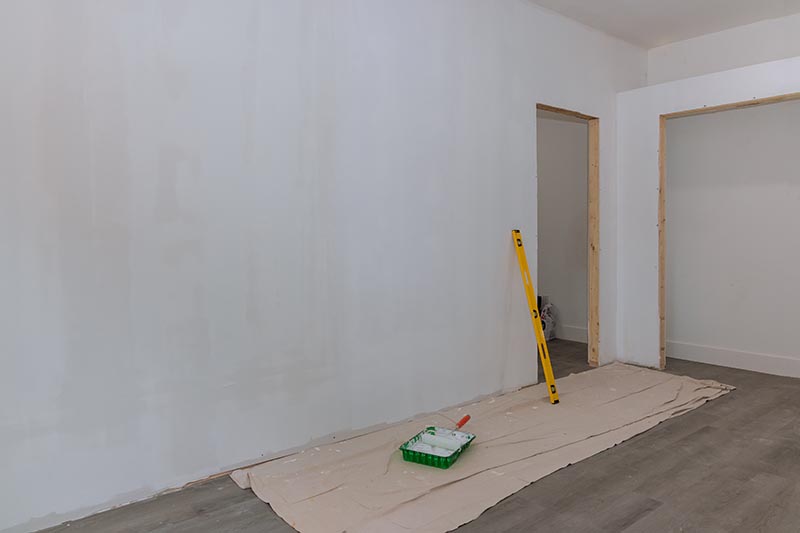How Many Coats of Primer on New Drywall Do You Need?
-
Pete Ortiz
- Last updated:

Drywall is ideal for interior wall designs because they are mold-, fire-, and moisture-resistant. Drywall is even better at soundproofing your home than other options. Painting new drywall can be exciting, and most people tend to be tempted to get a paintbrush and a roller and jump right in. Granted, paint can stick on unprimed walls; however, you risk getting cracked, blotched, or peeled results.
Made up of resins, paint solvent, and other additives, primers are applied to drywall to ensure that paint adheres to the wall. Primers also reduce the amount of paint absorbed by the wall, thus using fewer coats of paint. This saves you money in the long run. So, just how many coats of primer do you apply on drywall to get an even finish?
In general, two coats are enough when painting interior walls. However, the exact number of primer coats you need will depend on the paint color, drywall material, and the type of primer used. This article will discuss the different situations where different numbers of primer coats are needed and tips for applying primer on drywall for a spectacular finish. Read on to learn more.
What Is a Primer and When Do I Use It?
Before we discuss how many coats of primer you need for your interior walls, it’s best you first know what a primer is and what it does.
While primer may look like paint in appearance, it is not. This is because it is composed of a higher concentration of resin than pigments and lacks a sheen. The resin content on primers has two functions: seal porous wall surfaces and prevent the bleeding of tannins and stains from wooden surfaces.
The best stain-inhibiting primers are water-based, but if you want a primer for extra stain blocking, shellac-based products will not disappoint. If you want to add fresh paint to drywall, a drywall primer would be ideal. This type of primer contains Polyvinyl acetate (PVA), a similar chemical used on carpenter’s glue to make it more adhesive. So, after application, the primer will not experience lifting or peeling, even after a few months.

How Many Coats of Primer: Painting New Drywall?
Usually, priming jobs require two coats. The only time priming with one coat is suitable is when repainting a wall with the same color or one that closely resembles it. High-end primer paints that feature primer products are ideal for a single coat.
The quality of paint also matters because you can successfully paint over a wall with a roller and then touch up the streaks with a brush later. Whichever the case, the situations below require either one or two primer coats.
Use One Primer Coat If:
1. Painting Over a White Wall
If you want to paint over white or very light paint, you will only need one coat of primer. A previously painted surface can take in another paint layer. Therefore, you won’t have to worry about the lighter base color peeking over the final coat. If the initial paint color was a medium-light shade and your current choice is very light, start by applying a single primer layer.
If the older coat still peeks, throw the new coat after drying up and add a second primer layer. High-quality water-based primer is the best for applying a single primer coat. For best results, bind the old white with the new shade, mask sanded or recently patched areas, and reduce the quantity of the new paint needed.
2. Using a Tinted Primer
You can imbue your primer with a shade of your new color to make dramatic changes to your interior walls. By neutralizing the underlying base color, you can turn dark walls into light and vice versa. This will reduce the amount of primer you need from two coats to one coat. Commercially produced tinted primers may not be readily available, but you can have your primer tinted for you in your local paint store.

Use Two Coats If:
1. Painting Over Unfinished Drywall or Plaster
Usually, plaster and dry walls that have never been painted or primed have different porosity. These areas will absorb paint at varying rates, which often results in blotches. In such a situation, paint experts recommend two coats of primer because chances are high that the first coat will be absorbed by the wall surface. The second coat will replenish the absorbed primer layer and conceal any blemishes, such as streaks on the wall.
To apply primer on drywall, first, apply a coat of primer-sealer. Since drywall primer sealer is thicker than the standard variety, you will get better surface coverage. When the layer dries, inspect the surface, and if any blemishes are present, you should apply a second primer coat.
2. Painting Over Unfinished Plaster
When applying a primer on unfinished plaster walls, use two coats of oil-based stain-blocking primer. Plaster walls are susceptible to stains that usually bleed through the final paint coat. Simply apply the first coat, wait for 12 to 24 hours, then apply the second coat.
3. Painting Over Masonry
Like wooden surfaces, masonry walls usually absorb a lot of primer or paint before the surface is sealed. When you paint over bare masonry, you may have to use a lot of paint before the surface is evenly smooth. Therefore, experts recommend priming masonry surfaces with two coats before painting.
For the first layer, use a water-based latex primer and let it dry for about two hours. If the first coat stains through, apply a second primer coat, which will be less patchy once it dries. This usually means that the surface is ready to accept paint.
4. Painting Over Concrete
If you want to paint over concrete walls, it’s best to prepare the surface with a primer. Two coats will create a smooth surface and hide any underlying blemishes. Simply apply two water-based primer coats for an even finish. The most common primer for concrete is acrylic primer. However, epoxy and polyurethane also work.

5. Painting Unfinished Wood
Unpainted and unprimed wood tends to be more porous than drywall. This can be attributed to the fact paint lacks enough solid content to fill the wood pores and flatten the grains on the surface. So, when you prime wooden surfaces, the result is usually uneven and prone to peeling and blotching.
Therefore, experts recommend you apply two coats of oil-based primers for a smoother finish. The high percentage of solid materials (resin) in the primer will cover up the pores, flatten the surface for painting, and conceal any knots on the wood. Apply the first coat, wait for about 12 to 24 hours, then prime with the second coat.
If you opt to use water-based primers, the moisture will cause the grains in the wood to swell. So, you will be forced to sand the surface after applying the first coat to level it. Yet, you must wait for at least 2 hours before applying the second coat.
6. Painting on Medium-Density Fiberboard (MDF)
If you want to paint over MDF surfaces, first start by sealing the edges. Then, proceed to apply two or even three coats of oil-based primers. Just like in wood, avoid using water-based primers because they can roughen the fibers, prohibiting sanding. Moreover, since MDF doesn’t absorb water as much as wood, you give it at least 24 hours for the first coat to dry before applying the second or third primer coat.
7. To Cover a Dark Paint Color With a Lighter Hue
As earlier mentioned, primers are crucial if you want to make dramatic changes in your wall color. If you don’t use a primer, the darker shade might peek through even after applying two or more coats of paint. To hide the base coat color, it’s best to use “high-hide” primers, which are specifically modified to completely cover darker shades of paint.
To cover a darker color with a lighter hue, simply apply two thin coats of tinted or white primer, but ensure they are a close match to the hue of the new paint. This way, your wall surface will be closer to the final paint color and reduce the number of coats required for a smooth, even finish.

When to Skip a Primer Altogether
If Using Self-Priming Paint
Though not recommended, there are specific instances where necessary. This is especially in situations when you will be using self-priming paint. Also known as two-in-one primer products, these primers contain more solid particles than the standard paint variety. Therefore, self-priming paints tend to be thicker.
Remember, if you apply one coat of self-priming paint, you’d better apply it over a similar or lighter shade of the base color. These paints are also ideal if the wall surface is smooth. They also take a bit longer to dry than standard paints.
The 4 Tips on How to Prime a Drywall
Now that you have a basic understanding of what a primer is, what it does and how many coats are required, you should be ready to give your interior walls fresh paint. To successfully prime your wall, you will need to:
- Fill up any cracks on your wall before attempting to prime the surface.
- As you apply your first primer coat, use even brush strokes while ensuring you cover all surfaces.
- Allow your surface to dry before applying the second coat. Most primers are designed to have a short drying period.
- Inspect your work, and if it doesn’t have any blemishes, proceed to paint. However, if the base color is peeking through or the surface is stained, you will need to apply another primer coat.
In Conclusion
There is nothing quite as frustrating as expending time, energy, and resources to give your walls a fresh coat of paint only to end up with blotched, peeling, patchy, and ugly finishes. Fortunately, you can avoid this disappointing experience by applying the appropriate number of primer coats before painting.
While you can apply just one primer coat layer to get a smooth finish, most priming jobs require at least two coats to get an even, smooth finish. This is especially so if you want to paint over unfinished wood, plaster, concrete, masonry, and MDF. One primer coat is only ideal if painting over a white or light surface or using self-priming paint.
If unsure how many primer coats you need for your surfaces, a paint store should give you recommendations. Alternatively, apply one coat, and inspect the surface after drying. If still uneven or heavily colored, apply another coat.
- When to or not Skip a Primer before painting
- Tips for Painting Over DryWall
- Instances When Priming your wall before painting is a must
- Everything you need to know about Painting Over Different Surfaces
- Is it Necessary to prime Before Painting
- How to Fix Holes on Dry walls
- Can drywall primer be used on Painted Walls
- Do masonry paints need a primer?
Featured Image Credit: New Africa, Shutterstock
Contents



